
The day Lone Jörgensen’s fascinating shooting star De Vito FBW shone at the World Cup qualifier in Neumünster I decided that it was really time to pay the blonde Dane a visit and show the readers of Eurodressage the place where world class horses such FBW Kennedy and Donna Asana were brought up.
After Lone’s return from Gothenburg I made an appointment for the weekend but on Friday Lone broke the news that her Württemberg gelding has caught a little cough and was enjoying some off days to recover. Though it’s a pity to miss out on seeing this highly talented in training I still wanted to do the walk on Lone Jorgensen's premises.
Visiting Lone and her partner Uli Eggers didn’t mean I had to travel 700 km north. Both live and train on the outskirts of Stuttgart only about 100 km from my home. As we have arranged to meet at noon I can have a usual Saturday-lie-in, but my mood plummetted when I looked out of the window: overcast sky, morning mist and a cold drizzle. This didn’t promise very good pictures.
While I speed through mist and some rain on the motorway I swear on the German weather forecast which had predicted spring-like temperatures and sunshine for Saturday. The sky clears a bit and the sun tries to fight through the thick wall of clouds before the motorway exit and I am happy to have a new, properly working GPS which leads me safely through several roundabouts and a very rural countryside with small villages. Next to a country road a riding stable with fields, paddock stalls and a horse walker comes in sight and sure enough, I miss the entrance and have to drive to the next village before I can turn my car around and give it another, successful, try.
We made an appointment for half past 11 and as I am a bit early I park the car opposite a stable block and look around, discovering a curious looking bay face: De Vito FBW is looking out of his window and checking the intruder with interest.
I prepare my camera when Uli Eggers arrives at the yard and a mere minute later his long time partner Lone Jörgensen is in sight.
We introduce ourselves and also Higgins comes to say “hello” to me, wagging his short tail enthusiastically and licking my hand as I stroke the friendly Norfolk terrier. "He accompanies us almost everywhere and loves travelling in the transporter. Only at Aachen we cannot take him with us. Dogs are not allowed there and there are also many evening festivities," says Lone about her 11-year-old dog with the charming saucer eyes.
Meeting the Quadrupeds
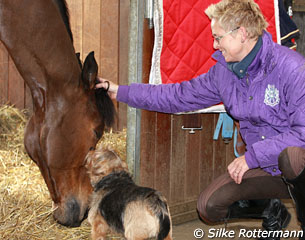 Hairy Higgins seems to like every living thing because the cute dog apparently cannot wait to welcome Lone’s top horse De Vito, the dressage shooting star of the past months, pawing at the door of his stall as soon as we have entered the small stable block which Uli Eggers and Lone Jörgensen have rented and which is a bit separated from the rest of this boarding stable. De Vito FBW, a leggy Württemberg branded De Niro-offspring, recognizes the little dog and knows what is to come. He already lowers his head before Lone pushes the door aside. Higgins immediately begins kissing the 171 cm big gelding’s nose which he licks passionately. De Vito enjoys this massage of his muzzle and nostrils and Lone is all smiles. “They are real friends. Sometimes De Vito also licks Higgins.”
Hairy Higgins seems to like every living thing because the cute dog apparently cannot wait to welcome Lone’s top horse De Vito, the dressage shooting star of the past months, pawing at the door of his stall as soon as we have entered the small stable block which Uli Eggers and Lone Jörgensen have rented and which is a bit separated from the rest of this boarding stable. De Vito FBW, a leggy Württemberg branded De Niro-offspring, recognizes the little dog and knows what is to come. He already lowers his head before Lone pushes the door aside. Higgins immediately begins kissing the 171 cm big gelding’s nose which he licks passionately. De Vito enjoys this massage of his muzzle and nostrils and Lone is all smiles. “They are real friends. Sometimes De Vito also licks Higgins.”
She kneels next to her dog and strokes her best horse’s head. De Vito, who is clipped and wears a maroon winter blanket, looks like he considers this royal treatment and the attention from everybody as the most natural thing for a horse of his talent and class. They who assume that Lone Jörgensen has an armada of dressage horses following in the footsteps of her top 10-year-old gelding are wrong. There is only one other horse of their own they train at home. “We usually buy the horses very young, some like De Vito even at foal age. Our other horse which is stabled here with us is Fiorella. We bought her as a 4-year-old and now she is 7 and progressing very well," Uli Eggers explained.
Fiorella, a chestnut Westfalian by Fürst Piccolo, is a mare at first sight. Big black eyes and an alert look and obviously devoted to Lone. “I really like working with mares. They are often divas and you cannot work them fast or in a strict way. With mares you need to make lots of compromises and sometimes you have to take some roundabouts to convince them, but if you establish a rapport they really try for you." Lone has to know what she is speaking about because the petite chestnut lady “who we hoped would grow a little bit more” isn’t Lone’s first mare.
The Jorgensen - Eggers Partnership
 Actually it had been a mare which turned the Dane from a talented jumping rider to the discipline of dressage. Lone came from Denmark to the south of Germany back in 1982 to work as a bereiter at Uli Eggers' jumping stable. “I soon discovered that she was really talented. My jumping horses were well ridden, they could do flying changes, working canter pirouettes, but only some weeks after Lone had started working with them they out of a blue did passage and piaffe. It was astonishing," Eggers reminisced about the beginning of their working relationship which turned out to become a private one as well.
Actually it had been a mare which turned the Dane from a talented jumping rider to the discipline of dressage. Lone came from Denmark to the south of Germany back in 1982 to work as a bereiter at Uli Eggers' jumping stable. “I soon discovered that she was really talented. My jumping horses were well ridden, they could do flying changes, working canter pirouettes, but only some weeks after Lone had started working with them they out of a blue did passage and piaffe. It was astonishing," Eggers reminisced about the beginning of their working relationship which turned out to become a private one as well.
The real kick for dressage was initiated by a bay Weinberg foal with the auction name “Wrong Number” which later became famous under the new name Wempe Juwel. “Weinberg inherits jumping as well as dressage ability. Think of Kurt Gravemeier’s great jumping horse Wum. It soon became obvious that our foal could do all, but jumping. So we tried her in dressage and that was the beginning of our exclusive dressage career," Eggers smiles.
Wempe Juwel made Lone a dressage rider and when the mare was sold to the Leida Strijk. The Dutch competed her successfully at the 1994 World Equestrian Games in The Hague and the pair won a bronze medal at the 1995 European Championships. The sale of Wempe Juwel didn’t mean Lone's goodbye to dressage, on the contrary!
Meanwhile Lone takes Fiorella out of her stall and gives her a quick brush-over. The mare appreciates the treatment and doesn’t mind the least when Uli Eggers opens the big wooden door to their stable block for me so that I can shoot the mare. She pricks her ears when the flash of my camera lightens up the not too bright short stable corridor, but she doesn’t bat an eyelid and patiently stands still until Lone has bandaged her legs. “Ah, she is very well behaved and a very cool horse. When we have a white cover or something which terrifies all the other horses Fiorella walks to the object to give it a closer inspection," Lone smiles.
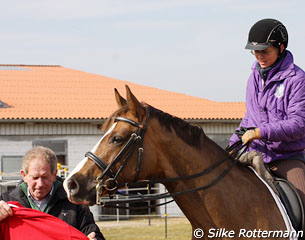 There’s no groom in sight and when I ask Lone’s partner about staff he tells me they don’t have any groom, neither at home nor at shows. “Well, there’s a girl who takes care of my other horse when I am away like now in Neumünster or Gothenburg. This is a disadvantage if you have a top class horse: You are away from home very, very much and often for more than just some days. And it doesn’t work having many horses at home and at the same time be away often, so we only have two horses here at the moment to focus on and then we are able to do it well. We never have a groom and take care of our horses by ourselves. This way you really get to know them very well and build a real relationship," Lone explains while she tries put the double bridle on her mare. But “Mausi”, as she’s affectionately called, has other ideas. She wants to be cuddled and puts her head on Lone’s shoulders, looking innocently.
There’s no groom in sight and when I ask Lone’s partner about staff he tells me they don’t have any groom, neither at home nor at shows. “Well, there’s a girl who takes care of my other horse when I am away like now in Neumünster or Gothenburg. This is a disadvantage if you have a top class horse: You are away from home very, very much and often for more than just some days. And it doesn’t work having many horses at home and at the same time be away often, so we only have two horses here at the moment to focus on and then we are able to do it well. We never have a groom and take care of our horses by ourselves. This way you really get to know them very well and build a real relationship," Lone explains while she tries put the double bridle on her mare. But “Mausi”, as she’s affectionately called, has other ideas. She wants to be cuddled and puts her head on Lone’s shoulders, looking innocently.
Lone laughs and fondles with her mare while De Vito FBW attentively observes the scenery in front of his stall. One cannot escape the feeling that he exactly knows what a young superstar he is. The way he looks at you, the way he observes everything that is going on inside and outside his stable. When Lone straightens the mare’s forelock I consider it a ideal to ask why all her horses wear an unbraided forelock in competition. “Well, I always used to let it open because plaited it looks a bit strange to me. One day Uli asked me to plait the forelock because it would look tidier. So I plaited the forelock and had the most disastrous ride imaginable. From then on I always let it open, I am a bit superstitious.”
Stepping Out with Fiorella
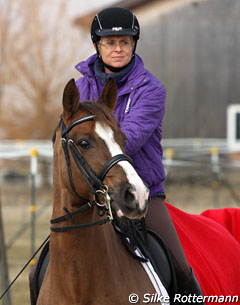 I had asked Lone beforehand if it is possible to take photos outside because they are more attractive than in an indoor arena and she had agreed. When the three of us plus Mausi head to the outdoor arena I regretfully think of the average weather outside, but surprise surprise: We step out and are welcomed by timid sunshine and a pale blue sky. I sigh with relief and Uli Eggers grins: “We call this place the 'Sun hole'. There can be bad weather all around, but the sun still often shines here.”
I had asked Lone beforehand if it is possible to take photos outside because they are more attractive than in an indoor arena and she had agreed. When the three of us plus Mausi head to the outdoor arena I regretfully think of the average weather outside, but surprise surprise: We step out and are welcomed by timid sunshine and a pale blue sky. I sigh with relief and Uli Eggers grins: “We call this place the 'Sun hole'. There can be bad weather all around, but the sun still often shines here.”
Lone fastens the chin strap of her velvet helmet adorned shining crystals and calls out to me: “This is the first time we are out for three months. It had been so freezing cold here so we used the indoor arena all the time. Let’s see how she behaves!”
We walk past another stable complex with small paddocks in front in which the horses enjoy the sunshine and can have a look at what’s going on in the arena. The outdoor arena is surrounded by fields and some houses at one side. At the horizon the small village with the church tower looms. It’s a peaceful scenery and while I think it’s remarkable that somebody like Lone works here on her next Olympic dream, Uli Eggers interrupts my thoughts: “Well, it’s not a luxurious facility here, but it’s very good for us.” I smile to myself because I prefer horse-friendly training and personal treatment to any glorious property with golden knobs on the corners of the stalls. Still this property is a nice one having all a horse needs.
Lone walks Mausi with given reins and I ask her partner if Lone only wears the helmet for the photo shoot or regularly. “No, she wears it regularly and now also in competitions. We were a bit unsure if she is allowed to wear it internationally so she wore it only in the warm-ups until the autumn. Then before Frankfurt we asked and since then Lone wears it also in competition.” Lone who passes us nods: “I think it is really important. The kids and teenagers mainly see us in competitions and not so often in warm-ups. So the competition is the most important place to wear a helmet and to set an example. I just read in a study that the most accidents related with horse sport happen at teenage age.”
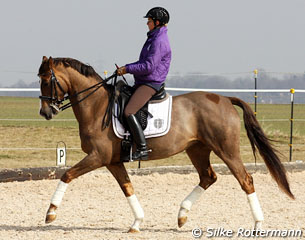 Lone takes the reins and starts in rising trot. Mausi has a cheerful way of working, the little mare is nippy and seems to love her job. She’s fresh, but there’s not the dangerous exuberance one too often finds in dressage horses. “She is so laid- back and pleasant in her work. She turns 7 now and hasn’t done any competing. I don’t like to push young horses too much," Eggers admits. "It is better to work them quietly and accordingly at home. Often we start our horses only when they are advanced. Mausi is now at a point where we can think about her S-level debut. We do half steps and a little passage and she also just practised one time changes."
Lone takes the reins and starts in rising trot. Mausi has a cheerful way of working, the little mare is nippy and seems to love her job. She’s fresh, but there’s not the dangerous exuberance one too often finds in dressage horses. “She is so laid- back and pleasant in her work. She turns 7 now and hasn’t done any competing. I don’t like to push young horses too much," Eggers admits. "It is better to work them quietly and accordingly at home. Often we start our horses only when they are advanced. Mausi is now at a point where we can think about her S-level debut. We do half steps and a little passage and she also just practised one time changes."
I ask him if the Nürnberger Burgpokal could be an aim for the mare, but he smiles and shakes his head: “No, not really. Nowadays you need an absolute exceptional mover to place highly in the final. So why should I push Mausi to end up in 6th or 7th place. No, I prefer giving her a quiet start.”
Meanwhile Lone practises some flying changes, but instead of three time changes Mausi eagerly wants to show what she has recently learnt and insists on doing one times. Lone laughs and explains her mare’s behaviour to me. She still needs some visible aids, but the mare already changes beautifully.
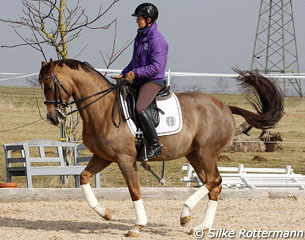 Her eagerness and willingness to please are also apparent when Lone asks for some half steps. Mausi tries hard and Lone praises her immediately before trying it some more times. “We learn the piaffe and the passage from the saddle. We think it’s the best way because there are some horses piaffing beautifully in hand, but struggle when they are under the saddle. It’s decisive they piaffe under the saddle," Eggers tells me.
Her eagerness and willingness to please are also apparent when Lone asks for some half steps. Mausi tries hard and Lone praises her immediately before trying it some more times. “We learn the piaffe and the passage from the saddle. We think it’s the best way because there are some horses piaffing beautifully in hand, but struggle when they are under the saddle. It’s decisive they piaffe under the saddle," Eggers tells me.
Ulli doesn’t interfere with Lone’s riding at all on that day, being busy answering my questions while I try making photos and listen to his interesting answers at the same time. Now and then Eggers rushes into action and collects the manure of the mare to keep the arena clean. Mausi has done enough for today. Not only did she do well and left a positive impression, but she also behaved absolutely impeccably outside after the winter break from the outdoor arena.
“Of course we also hack the horses. She’s a pleasure and also De Vito FBW is obedient. We didn’t enjoy hacks too much with Kennedy who was such a sensitive and spooky horse," Lone confesses. Kennedy was Lone's greatest partner to date, but the Wurttemberger gelding died last year at his new home in the USA. Eggers laughs: “Kennedy, yes, I always had to act as guard around the warm-up arena and show ring to keep everything quiet. Kennedy was just so sensitive and easily distracted. It is really easier with our two horses now. Both are relaxed and not spooky. But I tell you something: If you went through it all with a horse like Kennedy you realize it teaches you a lot!"
Looking Back on a Brilliant Career
We all walk back to the stables where Lone untacks the mare and Uli Eggers puts her under the solarium. Time had come to share some thoughts on Lone’s Grand Prix horses of the past. “Kennedy FBW really made my name and established me on the dressage scene. We bought him at the Marbach auction and went up the levels together. He was the Grand Prix horse we kept for the longest time because we knew he was the key for me,” Lone explained.
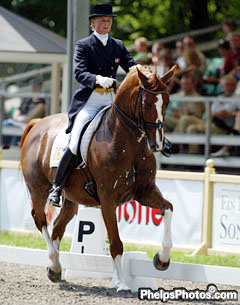 The coloured chestnut not only put Lone’s name on the map of international dressage, but also that of Baden-Württemberg breeding. “Of course it’s never easy to sell, but we have to make a living and the show circuit has become really expensive and in comparison there is not too much to win and cover the running costs. As we buy the horses as foals or very young ones and bring them up by ourselves they are also a kind of investment”, Uli Eggers says. Lone agrees: “Of course the Danish Federation supports us by covering some of the costs, for example training with Rudolf Zeilinger or at championships, but the main costs have to be funded by us. For example when we travelled to Gothenburg I had to pay about 600 € alone for lorry toll.”
The coloured chestnut not only put Lone’s name on the map of international dressage, but also that of Baden-Württemberg breeding. “Of course it’s never easy to sell, but we have to make a living and the show circuit has become really expensive and in comparison there is not too much to win and cover the running costs. As we buy the horses as foals or very young ones and bring them up by ourselves they are also a kind of investment”, Uli Eggers says. Lone agrees: “Of course the Danish Federation supports us by covering some of the costs, for example training with Rudolf Zeilinger or at championships, but the main costs have to be funded by us. For example when we travelled to Gothenburg I had to pay about 600 € alone for lorry toll.”
When Kennedy was sold to the US, he formed another impressive partnership with Robert Dover. Lone made the Danish team again on the Oldenburger Ludewig G who was a lookalike of Nicole Uphoff’s legendary Rembrandt. Unfortunately Ludewig G was “something between genius and insanity”. One time he could score highly, the other he could also be tense. This happened exactly on a critical moment when he failed to impress as Danish WEG team member in 2006.
“That was a real pity because Ludewig excelled in the training the days before, but when we were in this huge Aachen main stadium the acoustic was strange and he just didn’t cope.” The blood influenced bay was sold to Brasil, but Lone soon made a come back with Donna Asana.
Without a doubt this most beautiful chestnut mare was a once in a lifetime horse regarding quality and talent. Sired by Don Schufro the Danish mare came into the limelight as an only 8-year-old in 2008. Despite being one of Denmark’s high scorers during the 2008 Olympic season Lone decided against a start in Hong Kong and sold the mare at the beginning of 2009 to Evelyn Haim- Swarovski. Tragically Donna Asana died untimely at the end of 2010. Lone is still very sad remembering her former mare: “It was such a pity. But it was like with Peron who also died of an allergic shock to a treatment. Horses are just such big sensitive animals and so easily something happens to them.”
A Colourful Future
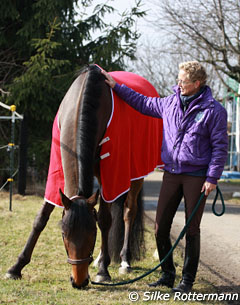 For Jorgensen this is a reason why her horses are allowed to be turned out in a paddock at a younger age, but no longer when they reach the highest levels. “When we have bought a foal it was reared by someone we have faith in. Currently we have two three-year-olds which we bought as foals at a lady living near Göppingen. We take them in our stable here when they are about four and when we think they are ready we break them in, but after that put them in a field again until they are 5. Sometimes horses are just not mature enough to be broken in at 4 then we wait for another year. De Vito FBW was only broken in that age because when we tried it at 4 he was just too unbalanced and we called it quits for another year," Eggers explained.
For Jorgensen this is a reason why her horses are allowed to be turned out in a paddock at a younger age, but no longer when they reach the highest levels. “When we have bought a foal it was reared by someone we have faith in. Currently we have two three-year-olds which we bought as foals at a lady living near Göppingen. We take them in our stable here when they are about four and when we think they are ready we break them in, but after that put them in a field again until they are 5. Sometimes horses are just not mature enough to be broken in at 4 then we wait for another year. De Vito FBW was only broken in that age because when we tried it at 4 he was just too unbalanced and we called it quits for another year," Eggers explained.
Lone beams when she shows me a picture on her iPhone showing the two before mentioned youngsters which are being reared, a black and a paint! “Lone wanted to have a paint. Well, so we bought him as a foal. He is by Rosenstein (by Blue Hors Romanov) and the dam goes back to the Sambuco line.”
Whereas Lone’s youngsters enjoy lots of freedom in their younger years, her dressage horses don’t move freely in the two big fields rented by her and her partner. ”We let them graze outside on a lunge line for about an hour each day. Just to relax their minds. Even a sport horse should have the possibility to have the sunshine on its back and be out in the fresh air every day. To let them move freely in a field holds big risks. In seconds the work of many years can be shattered. Our horses are so valuable. Of course horses can also injure themselves fatally on the lunge line, but we try to keep the risk as low as possible," Ulli stated.
FBW De Vito's Time
For Lone’s rising star De Vito it’s nothing more than letting the sunshine warm his fur on this day. Although Lone immediately notified me that her horse, which had just qualified for the World Cup Final in April, had sustained a slight cold and should rest some days, I regret it a bit not seeing him under the saddle. I had seen the horse during the 2011 season and in Neumünster and to shoot such a breathtaking mover in a training session would have been a thrill.
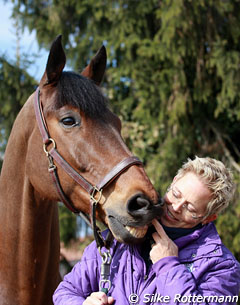 The same way Lone passionately wanted a paint, Uli Eggers craved for a De Niro foal. This led them to De Vito almost 10 years ago. ”In 2002 I decided that this year I wanted to have a De Niro foal and asked a friend who visits many foal shows to keep his eyes open. He suggested some foals to me and in the end one of them was De Vito. The day I looked at him in Ravensburg there was awful weather. I asked his breeder Mrs. Ruitz to trot his mare up a hill so I could see the foal trot. De Vito trotted completely balanced in the same manner uphill as downhill. He had such a sensational balance," said Eggers.
The same way Lone passionately wanted a paint, Uli Eggers craved for a De Niro foal. This led them to De Vito almost 10 years ago. ”In 2002 I decided that this year I wanted to have a De Niro foal and asked a friend who visits many foal shows to keep his eyes open. He suggested some foals to me and in the end one of them was De Vito. The day I looked at him in Ravensburg there was awful weather. I asked his breeder Mrs. Ruitz to trot his mare up a hill so I could see the foal trot. De Vito trotted completely balanced in the same manner uphill as downhill. He had such a sensational balance," said Eggers.
De Vito was raised at Ingrid Gauss's place near Göppingen, just like their two new youngsters, before he was broken in at age five. “He was so easy to break in, really uncomplicated. You could have put the dog on him for that," Lone jokes and finishes her brushing session by putting De Vito's brown leather headcollar on.
“We competed him very little when he was a young horse. At 6 he had 2 starts, one with me when I qualified him for the Bundeschampionat and one with our daughter Monica who needed a good A-dressage result to get a riding badge. Then we went to Warendorf. We already had Kennedy there years earlier. De Vito was 5th in the warm-up class and we were optimistic he would do well the next day. It was after 7 in the morning and I prepared him in the big warm-up ring behind the dressage stadium when somebody came up to me and said I am not allowed to ride De Vito here because the ponies would come at 8 am. I could see no pony at all during that time, but I left and they told me I had to warm-up in a ring further away where a farmer just put his horses in a field," Lone reminisced. Uli Eggers continues; “I was surprised to see Lone in this small ring when I came and then I told her we would go home. We couldn’t see any sense in stressing such a young horse warming him up under such circumstances where at the same time we could have easily have provided him with the best conditions in an empty warm-up ring. So we loaded De Vito on the trailer and went home. It was not a popular decision and we were aware of it. But we thought and still think that the Bundeschampionat is the stage for the best young horses and then they should have the best conditions, wouldn’t you agree?”
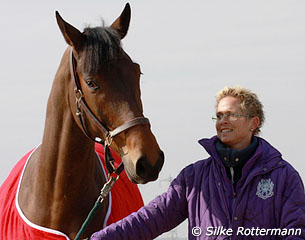 The missed success in Warendorf hasn’t hindered the leggy elegant bay with intelligent bright eyes to mature into a horse of world class potential. He had a dream-like first Grand Prix season in 2011. “This wouldn’t have been possible without Rudolf Zeilinger to whom I regularly drive for training. He helped us enormously with De Vito’s training over the past 18 months. We are really working as a team and without Rudolf’s support it wouldn’t have worked so exceptionally well like it did," Lone said about her long time trainer’s support in her success. “Rudolf is our Danish national trainer for 15 years now, the oldest on duty around and I owe him much.”
The missed success in Warendorf hasn’t hindered the leggy elegant bay with intelligent bright eyes to mature into a horse of world class potential. He had a dream-like first Grand Prix season in 2011. “This wouldn’t have been possible without Rudolf Zeilinger to whom I regularly drive for training. He helped us enormously with De Vito’s training over the past 18 months. We are really working as a team and without Rudolf’s support it wouldn’t have worked so exceptionally well like it did," Lone said about her long time trainer’s support in her success. “Rudolf is our Danish national trainer for 15 years now, the oldest on duty around and I owe him much.”
Lone leads De Vito into the sunshine outside and he snorts a bit before he strikes the perfect pose in front of the stable while I scramble to his feet to get the right angle with the fir trees behind. Lone laughs and you can feel the affection she has for her horse. “He is always like that. He might take a look at things and snort a bit, but as soon as he pushes his head under my arm his world is okay again. But that is only when I handle him from the ground. When I sit on him he is calm and confident and passes any supposed monster without hesitation. So he’s quite easy on shows. He doesn’t need to know an arena beforehand to perform to his abilities.”
2011 has been the Württemberger gelding’s first Grand Prix season starting with a young horse’ GP class at the CDN Ludwigsburg and then switching to the Grand Prix later in the season. De Vito didn’t fail to impress on the international scene later on, placing at Kaposvar, Milan, Salzburg, Stuttgart and Frankfurt.
“Then we gave him a break until Neumünster. We consider it very important, in particular when the horses are on the way to Grand Prix, that they have rather few starts and work quietly in between to improve. So after Frankfurt we went back to the basics with De Vito FBW and worked with him," Lone tells me while walking next to De Vito who considers the wide, flat landscape next to the property quite fascinating. He holds his head high and takes a good look around while his rider cannot stop smiling on him. He settles down and nips at the first timid grass growing alongside the path we are walking. De Vito doesn’t seem to be the horse who was growing so quickly and successfully into the Grand Prix sport, but just a horse like any other which is very sure that there’s nothing better than these pale blades of grass. Lone looks happily at him and says to home, “taking some vitamins, eh?”
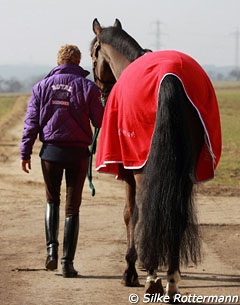 Is this the beginning of the grazing season or the beginning of an Olympic year for this horse? Who knows? I cannot hold myself back asking Lone on what she thinks about their chances. “Of course with horses you never know, but why not? Last year we started his Grand Prix career and now London doesn’t look out of sight for us, that is really great. De Vito has improved with each Grand Prix test, not tremendously but continuously. There are only three pairs allowed on the Danish team in London and it is early in the season. We have some good new horses and Digby is still in his winter break. Let me say it like that: We are doing our homework here and then we will see.”
Is this the beginning of the grazing season or the beginning of an Olympic year for this horse? Who knows? I cannot hold myself back asking Lone on what she thinks about their chances. “Of course with horses you never know, but why not? Last year we started his Grand Prix career and now London doesn’t look out of sight for us, that is really great. De Vito has improved with each Grand Prix test, not tremendously but continuously. There are only three pairs allowed on the Danish team in London and it is early in the season. We have some good new horses and Digby is still in his winter break. Let me say it like that: We are doing our homework here and then we will see.”
When De Vito FBW is back in his stall Lone and her partner head off home and so do I.
When I drive my car slowly past the stable block I catch the meaningful look of a young Grand Prix horse which has the talent and gut to follow in his predecessor Kennedy’s footsteps. If he were able to speak I am sure he would reassure me that he is classy enough to meet the rest of the best at London in August.
Text and Photos © Silke Rottermann for Eurodressage.com
Related Links
Eurodressage's Walks on the Premises
Dressage Next to the Castle: A Touch of CDI to the 2011 CDN Ludwigsburg
Lone Jorgensen Not to Compete at the 2008 Olympic Games
Lone Jorgensen Completes 2004 Danish Olympic Team
Lone Joergensen, Dominating Danish Dressage Dame at 2001 Danish Championships